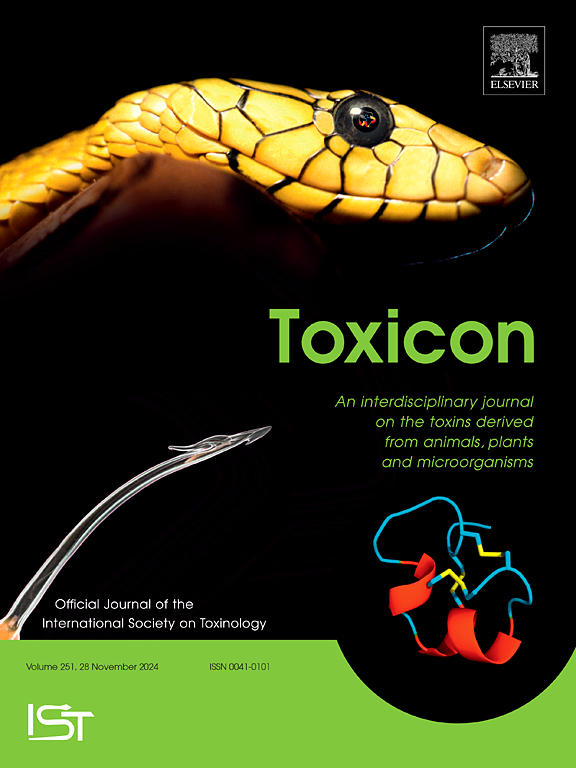Unique physiological and regulatory activity drives divergent toxin and non-toxin gene expression in rattlesnake accessory venom glands
IF 2.6
4区 医学
Q2 PHARMACOLOGY & PHARMACY
引用次数: 0
Abstract
Understanding the mechanisms by which organs and tissues evolve new physiological functions is central to understanding the evolution of novelty. This is particularly interesting in the context of related tissues that evolve specialized, yet complementary, functions. Snake venom glands are an attractive system to test hypotheses related to the evolution and specialization of novel physiological function, as these modified salivary glands have evolved over ∼60 MY to synthesize and store venom. Front-fanged venomous snakes (elapids and viperids) possess two types of venom glands: the main and accessory glands. The larger main gland produces greater quantities of venom toxins and has been studied extensively, while the smaller accessory gland has received less attention. Here, we explore gene expression differences between main and accessory venom glands across three rattlesnake species (Crotalus cerberus, C. oreganus concolor and C. viridis). Our findings indicate that accessory glands express most venom genes at significantly lower levels than the main gland, with a few exceptions that may represent biologically relevant contributions of accessory glands to venom. The two glands also exhibit distinct trans-regulatory environments that we link to key differences in their underlying physiology and secretory roles. Our results further suggest that two signaling pathways that regulate venom, the unfolded protein response (UPR) and extracellular signal-regulated kinase (ERK), show significantly lower activation in the accessory gland. These findings provide insight into the physiological and functional diversification of snake venom systems, highlighting how distinct glandular systems have evolved contrasting and complementary roles driven by distinct physiological and regulatory mechanisms.
独特的生理和调节活动驱动响尾蛇副毒腺中不同的毒素和非毒素基因表达
理解器官和组织进化新生理功能的机制是理解新颖性进化的核心。这在相关组织进化出专门的,但互补的功能的背景下特别有趣。蛇毒腺是一个有吸引力的系统,用于测试与新生理功能的进化和专门化有关的假设,因为这些修饰的唾液腺已经进化了大约60多年来合成和储存毒液。前牙毒蛇(elapids和viperids)有两种类型的毒腺:主腺和副腺。较大的主腺产生更多的毒液毒素,已被广泛研究,而较小的副腺受到较少的关注。本文研究了三种响尾蛇(Crotalus cerberus, C. oreganus concolor和C. viridis)主毒腺和副毒腺的基因表达差异。我们的研究结果表明,副腺表达大多数毒液基因的水平明显低于主腺,除了少数例外,可能代表副腺对毒液的生物学相关贡献。这两个腺体也表现出不同的跨调节环境,我们将其与潜在生理和分泌作用的关键差异联系起来。我们的研究结果进一步表明,调节毒液的两种信号通路,未折叠蛋白反应(UPR)和细胞外信号调节激酶(ERK),在副腺中的激活明显降低。这些发现为蛇毒系统的生理和功能多样化提供了见解,突出了不同的腺体系统如何在不同的生理和调节机制驱动下进化出对比和互补的作用。
本文章由计算机程序翻译,如有差异,请以英文原文为准。
求助全文
约1分钟内获得全文
求助全文
来源期刊

Toxicon
医学-毒理学
CiteScore
4.80
自引率
10.70%
发文量
358
审稿时长
68 days
期刊介绍:
Toxicon has an open access mirror Toxicon: X, sharing the same aims and scope, editorial team, submission system and rigorous peer review. An introductory offer Toxicon: X - full waiver of the Open Access fee.
Toxicon''s "aims and scope" are to publish:
-articles containing the results of original research on problems related to toxins derived from animals, plants and microorganisms
-papers on novel findings related to the chemical, pharmacological, toxicological, and immunological properties of natural toxins
-molecular biological studies of toxins and other genes from poisonous and venomous organisms that advance understanding of the role or function of toxins
-clinical observations on poisoning and envenoming where a new therapeutic principle has been proposed or a decidedly superior clinical result has been obtained.
-material on the use of toxins as tools in studying biological processes and material on subjects related to venom and antivenom problems.
-articles on the translational application of toxins, for example as drugs and insecticides
-epidemiological studies on envenoming or poisoning, so long as they highlight a previously unrecognised medical problem or provide insight into the prevention or medical treatment of envenoming or poisoning. Retrospective surveys of hospital records, especially those lacking species identification, will not be considered for publication. Properly designed prospective community-based surveys are strongly encouraged.
-articles describing well-known activities of venoms, such as antibacterial, anticancer, and analgesic activities of arachnid venoms, without any attempt to define the mechanism of action or purify the active component, will not be considered for publication in Toxicon.
-review articles on problems related to toxinology.
To encourage the exchange of ideas, sections of the journal may be devoted to Short Communications, Letters to the Editor and activities of the affiliated societies.
 求助内容:
求助内容: 应助结果提醒方式:
应助结果提醒方式:


